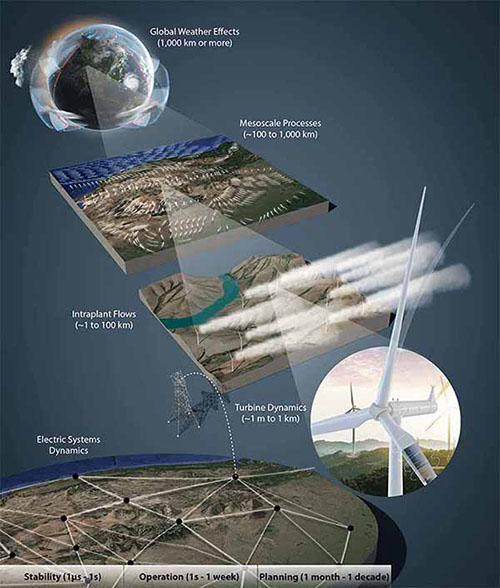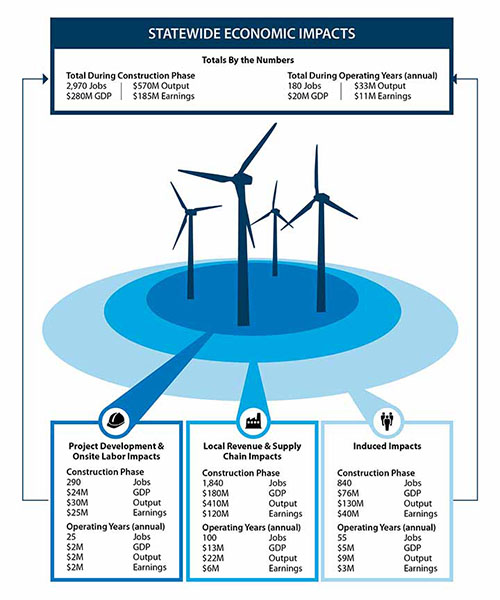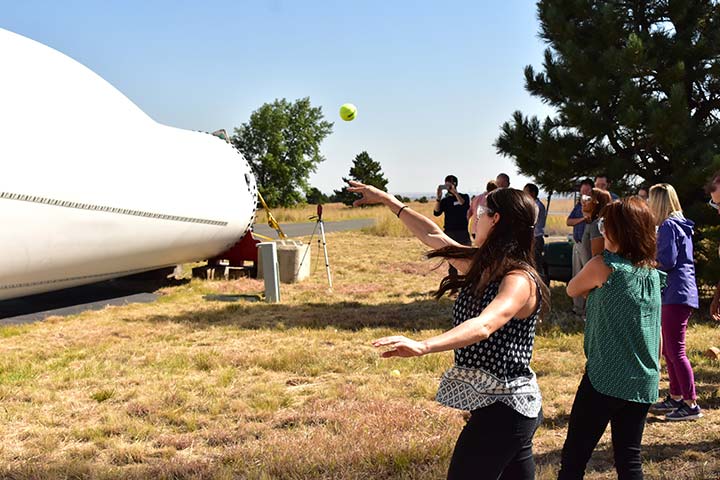The Leading Edge: October 2019 Wind Energy Newsletter
In this edition of the Leading Edge, NREL researchers discuss grand challenges in the science of wind energy, investigate economic and social impacts of wind energy in rural communities, explore future areas of work in wind-wildlife research, and much more.
News Stories

Wind energy's scientific grand challenges span vast scales both in terms of space and time. Mastering the physics and addressing the related research needs across these scales will position wind energy to serve as a primary source of future energy supply for the world. Illustration by Josh Bauer and Besiki Kazaishvili, NREL.
NREL Publishes Science Journal Article Posing Three Challenges to Wind Energy Potential
NREL researchers are among a team of authors inviting the scientific community to address three challenges that will drive the innovation needed for wind to become one of the world's primary sources of low-cost electricity generation.
Read more about the journal article published in Science today.
NREL Brings Together Collaboration in Composite Materials Manufacturing Research
Something about a 200-ft blade, heavier than an elephant, and spinning over 100 miles an hour, seems improbable—a triumph of manufacturing that often leaves onlookers in wonder. At NREL however, wonder is mixed with an ambition to improve. Beneath the towering test turbines at the National Wind Technology Center, NREL hosts a collaborative research environment that enables workers to build their skills in the growing composite manufacturing industry and push industry frontiers.
Colorado Case Study Demonstrates Economic Impacts from In-State Wind Manufacturing

Summary of statewide economic impacts from the 600-megawatt Rush Creek Wind Farm supported during the construction phase and operating years. Image courtesy of NREL.
An NREL case study of Xcel Energy's 600-MW Rush Creek Wind Farm—Colorado's largest wind energy project—highlights the positive impacts that result from in-state wind turbine manufacturing during both the relatively short construction phase and the longer-term operation and maintenance phase. In-state wind turbine manufacturing and installation support both short-term and long-term jobs and other economic impacts, according to the Economic Impacts from Wind Energy in Colorado—Case Study: Rush Creek Wind Farm. Study results could potentially be applied to other states.
NREL Researchers Share Work at American Wind Energy Association Offshore
NREL researchers will attend the American Wind Energy Association Offshore WINDPOWER Conference alongside staff from the Wind Energy Technologies Office. The event takes place Oct. 21–23, 2019, in Boston and provides attendees with an opportunity to engage in panels, presentations, and discussions about the status and future of offshore wind in the U.S.
Read more about NREL research being presented at AWEA Offshore.
Training Convenes Wind-Wildlife Experts to Share Latest Research and Emerging Technologies

Nearly 30 members of the U.S. Department of Energy (DOE) Wind Energy Technologies Office visited NREL's Flatirons Campus to discuss and identify the best wind-wildlife impact minimization strategies for the efficient deployment of cost-effective wind energy projects across the U.S. Training participants identified several challenges that require further attention—chiefly data collection and analysis.
Read more about the training and its outcomes.
On the Radar
Register for Upcoming North American Wind Energy Academy
NREL, in partnership with the University of Massachusetts-Amherst, is hosting two mini-workshops on Thursday, Oct. 17, 2019, in conjunction with the NAWEA/WindTech 2019 Conference in Amherst, Massachusetts. Workshops are open to anyone who registers for the NAWEA/WindTech 2019 Conference, but each workshop is limited to 50 registrants.
NREL Advances International Wind Research
The Executive Committee of the International Energy Agency Wind Technology Collaboration Program (widely referred to as "IEA Wind") has recently approved for release a set of documents entitled, IEA Recommended Practice for Selecting Renewable Power Forecasting Solutions (downloadable PDF). NREL researchers contributed heavily to the second part of the document set, which addresses designing and executing forecasting benchmarks and trials (downloadable PDF). The IEA Wind Executive Committee also elected NREL Wind Energy Laboratory Program Manager Brian Smith as IEA vice president for the 11th year.
Downwind—In Case You Missed It
NREL Offshore Wind Research Featured in the People's Power Hour
The People's Power Hour in New Orleans featured NREL offshore wind research conducted for the Bureau of Ocean Energy Management, which focuses on how offshore wind can support Louisiana.
New Grid Modernization Laboratory Consortium Report Details Role of Renewables in Stabilizing Energy Systems
A new report published through DOE's Grid Modernization Laboratory Consortium summarizes an extensive body of work pertaining to grid control: How can wind power, alongside a few short-term storage technologies, improve the reliability of power systems? The research cataloged in this report covers three years of full-scale demonstrations of active power control using grid assets coordinated between institutions in a real-time "super laboratory."
Recent Wind Publications
NREL's Balance-of-System Cost Model for Land-Based Wind
This NREL technical report summarizes the approach, methods, and equations used to develop Version 2.1 of NREL's Land-based Balance of System Systems Engineering (LandBOSSE) model. LandBOSSE models land-based wind balance-of-system installation costs, which currently comprise about 30% of the total costs needed to install a land-based wind power plant.
Investigation of Innovative Rotor Concepts for the Big Adaptive Rotor Project
During the past few decades, substantial reductions in the cost of wind energy have come from increases in rotor size, as larger rotors capture substantially more energy with a greater swept area and access to increased wind speeds at greater elevations. This NREL technical report analyzes novel concepts that have the potential to reduce the levelized cost of energy for 100-meter+ land-based wind turbines. The concepts were evaluated at a 2018 workshop and by national lab experts, and six concepts are recommended for future research and development: downwind turbines, distributed aerodynamic devices, multielement airfoils, highly flexible blades, flexible high tip-speed-ratio blades, and inflatable blades.
Sensitivity Analysis of the Effect of Wind Characteristics and Turbine Properties on Wind Turbine Loads
This work assesses which wind inflow and turbine input parameters have the greatest influence on turbine power, fatigue loads, and ultimate loads during normal turbine operation. Using the NREL 5-megawatt baseline wind turbine, separate case studies were performed on wind-inflow conditions and turbine structural and aerodynamic properties. Published in the journal Wind Energy Science, this research can be used to help establish uncertainty bars around the predictions of engineering models during validation efforts and provide insight on probabilistic design methods and site suitability analyses.
Share

